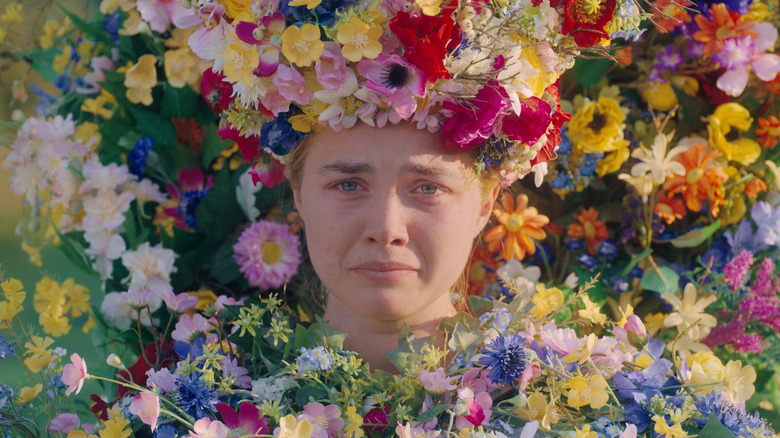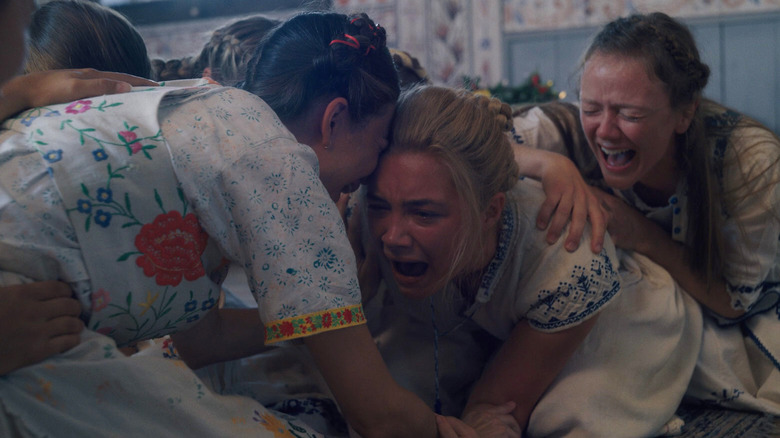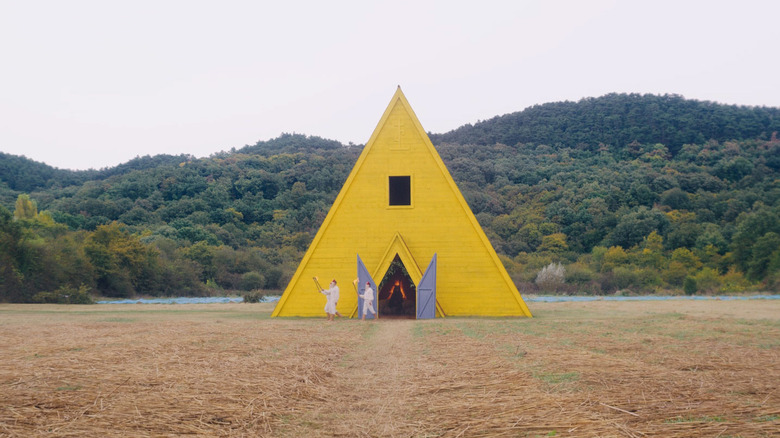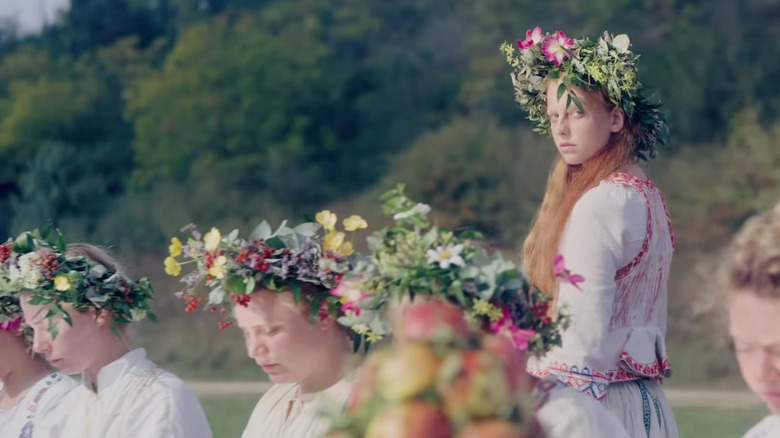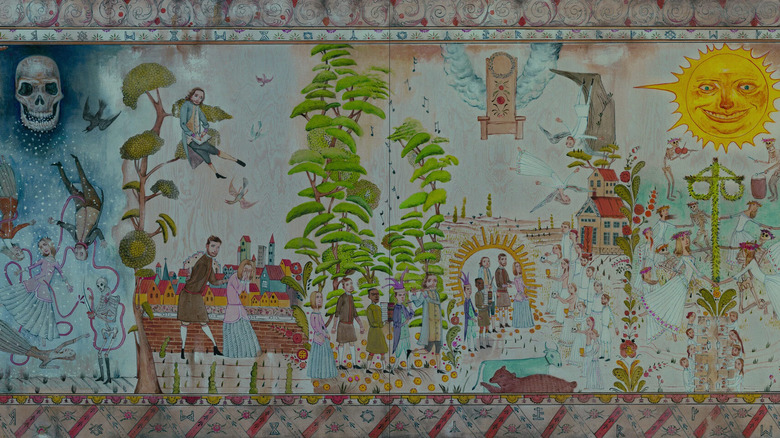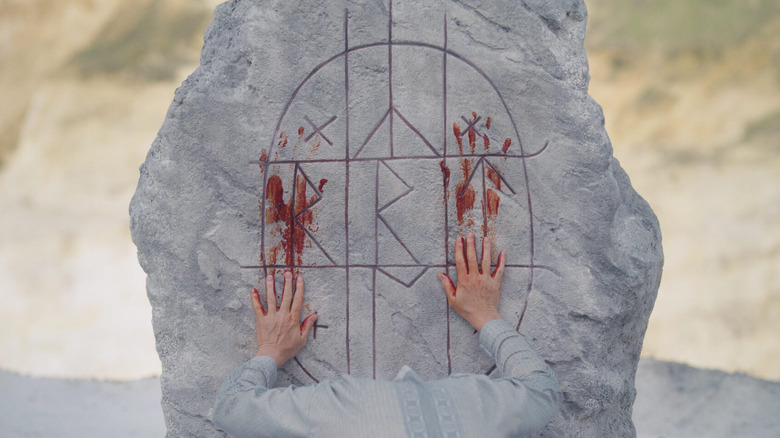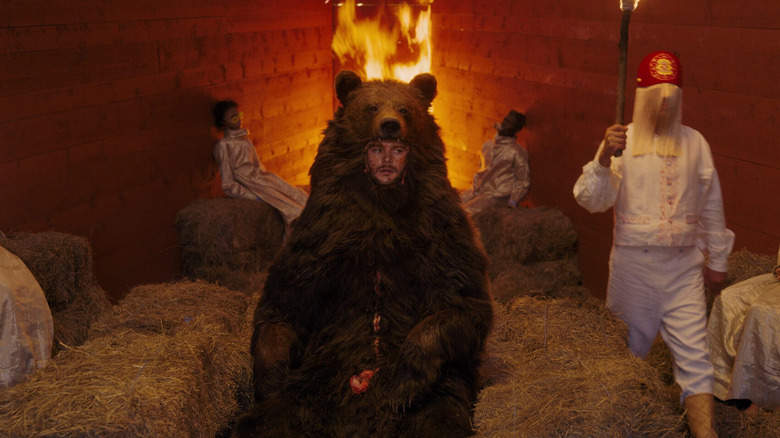Midsommar Ending Explained: Bad Breakups, Burning Buildings, And Bears, Oh My!
The A24 daylight horror "Midsommar" isn't your typical slasher or haunted house flick. Writer and director Ari Aster balances running meta-commentaries on trauma, gender, relationships, race, cults, and personal identity all while providing plenty of scares and a surprising number of laughs.
"Midsommar" follows Dani (Florence Pugh) after she loses her entire family in an unspeakable tragedy. Her relationship with her boyfriend Christian (Jack Reynor) isn't great, but he invites her along on a trip with him and his friends to a remote village in Sweden anyway. Christian and his friends Josh (William Jackson Harper) and Mark (Will Poulter) are going with transfer student Pelle (Vilhelm Blomgren) to witness an ancient ceremony that only happens once every 90 years. They are met by Connie (Ellora Torchia) and Simon (Archie Madekwe), students from London brought by Pelle's brother, Ingemar (Hampus Hallberg).
Because of the village's placement on the globe in rural Hälsingland, Sweden, they have days in the summertime where the sun shines for 23 hours or more. This near-constant daylight is already disorienting, but the people of the commune of Hårga also encourage their visitors to take psychedelic drugs. Things go from strange to scary as the guests start disappearing one by one. By the time "Midsommar" ends, Dani has gone through all of the stages of grief for her family, her relationship, and her former self. So how does the violent, wild ending of "Midsommar" stand up now that the shock has worn off?
Let's take a look, spoilers and all.
Communal Catharsis and Shared Grief
Dani, Christian, and the rest of the visitors are understandably shaken after witnessing an ättestupa, a ritual in which two elders sacrifice themselves by jumping off a cliff. Connie and Simon both take off, allegedly getting rides back to town. Dani and Christian begin arguing more, as she doesn't feel safe in this bizarre environment. Meanwhile, Hårga member Maja (Isabelle Grill) clearly has eyes for Christian, and she sets about doing a love spell ritual that involves feeding him her pubic hair and menstrual blood.
Dani participates in more rituals with the Hårga, including a dance around the maypole while high on psychedelic tea to choose the new May Queen. Dani is the last one standing and is crowned the May Queen, adorned in a crown of flowers and carried around on a platform and pulled in a human-drawn carriage. While she's off performing a harvest ritual using flowers and other sacrificial items, Christian participates in a sex ritual with Maja and many of the other women. Dani catches him in the act and runs, sobbing, into the young people's living area. She's caught by the other young women, who hold her and begin sobbing along with her.
Throughout the course of Dani's ordeal, she has felt isolated. Christian never made her feel supported or loved, and her own family was gone. The women of the Hårga embrace her and make her "feel held" as they share in her grief. Dani has been looking for community all along, and she's finally found it. The question becomes whether that community is better or worse than her isolation.
A 21st Century Fable
After Dani and Christian each go through their separate ordeals, the Hårga prep them for the final ceremony. We discover that Mark, Connie, Josh, and Simon were all killed by the commune and each has been dressed to represent their place as a sacrifice. Pelle's brother, heartbroken over Connie, offers himself as one of the sacrificial members from Hårga, alongside another member named Ulf. As the May Queen, Dani is expected to choose the final sacrifice and is offered two choices: a random villager, or Christian, sewn into the skin of a grizzly bear. She chooses Christian, of course, in what's possibly the harshest breakup of all time. Christian is taken into the yellow, pyramid shaped temple, and then the members of the commune light it ablaze.
Dani and the rest of the commune flail and scream in unison with the men who are trapped, burning alive inside of the temple. They share in more communal suffering, but the final shot lingers on Dani's face as a smile breaks across her face.
While that smile is extremely cathartic for Dani and anyone who identifies with her struggle, it's also a little scary. Dani went from being isolated and miserable to held and happy, but at what cost? Nine people are dead, counting the elders, and Dani has joined a commune that's fine with drugging people and ritual sacrifice. It's a great "be careful what you wish for" kind of fable, because there's no telling what kinds of horrors Dani might eventually commit herself as a member of Hårga.
Differences in the Director's Cut
Ari Aster's original vision for "Midsommar" ran long — clocking in at nearly three hours. Subplots that gave characters more depth were dropped, because most of them intertwined too deeply to cut one and leave the others. Thankfully, Aster and A24 released his director's cut, which provides more context for the film's fiery finale.
Included in the director's cut are extended scenes of Christian and Josh's dueling theses, some hints that the Hårga are white supremacists, a sequence that explains Connie's death by drowning, and more. The scenes make Hårga seem much more sinister, and Dani's joining them at the end is much more bittersweet. It does also show just how awful most of the visiting Americans are, providing heavier commentary on American imperialism.
Perhaps the most important scene added back into the director's cut shows Christian consenting to the sex ritual long before he takes any psychedelics. His betrayal of Dani is more concrete, making his brutal end just a teensy bit more justified. The director's cut is a much more complete story that gives viewers more to chew on, and fans of the theatrical cut are bound to get something out of it. Unfortunately, the only way to do that currently is on Apple TV or by finding one of the A24 special edition Blu rays.
"Midsommar" is a complex film with a lot to say, but its ending doesn't give any easy answers. Let's poke around at some of the other corners of the movie, and see what else we can discern.
The paintings tell the tale
There are numerous paintings in "Midsommar," including a massive tableau at the very beginning that depicts the events of the film through a fantastical interpretation. Artist Ragnar Persson and graphic designer Nille Svensson worked together to create the many paintings in "Midsommar," including all of the tiny paintings in the house where the young people sleep. There are clues throughout the paintings, including an example of how Maja uses blood magic to "seduce" Christian and references to the various sacrifices that end up taking place.
The most impressive foreshadowing comes from the first painting, however, which depicts the events of the film in five distinct acts. The first frame is winter and depicts Dani's family, all trapped by the specter of Death, though Dani's cord is cut, signifying that she survives. The next panel shows Christian failing to comfort Dani as she cries, while Pelle watches and takes notes. Following this is a panel showing the whole gang as they stroll into Hårga, and then one with everyone gathered at some kind of ritual. Mark is depicted as the Fool, complete with the silly hat he's doomed to wear, while Josh is always shown carrying a stack of books.
The final panel shows the maypole dance and feast, with death lurking among the girls dancing. Instead of the huge skull looking down from the first panel, we see an ominous, grinning sun. Daylight horror is tough to pull off, but Aster and his team clearly understood the potential for scary sunlight.
Each victim has a rune
During the first ritual, the ättestupa, the two elders who sacrifice themselves cut their hands and rub the blood on a massive runestone. There are nine runes on the stone, all from the ancient Norse alphabet, called Elder Futhark. In addition to representing sounds and letters, the runes also represent specific concepts, and each of the nine sacrifices is represented by a rune. The number nine is important in Norse mythology, as it is a sacred number and the number of realms that exist.
There are four Gebo runes. Gebo means "gift," and these represent the four willing sacrifices from Hårga. There are two identical versions of the rune Raido, which represents travel and the two British visitors, Connie and Simon. Next to them is the rune Tiwaz, which represents justice; Christian wears this symbol on his clothing. The bottom rune is Perthro, representing secrets and mysteries, which Josh tries to uncover, and the top rune is Algiz, a symbol of protection, though it is inverted. This inversion means it's the opposite of protection and is instead desecration, which fits perfectly with Mark, who desecrates their sacred tree by urinating on it.
There's plenty of other hints with the runes, as they are absolutely everywhere in the film, but one of the most telling is the one carved on the bottom of Josh's foot: Dagaz, which represents enlightenment. Josh was so curious to discover more about the Hårga that he violated their trust, and his search for "enlightenment" was what cursed him to his death.
The flaming bear
Not all of the symbolism in "Midsommar" comes from literal symbols, however. In the film's final sequence, Christian is sewn into a bear skin and then put into the sacrificial triangle house with all of the others. Why a bear, though?
In Norse mythology, bears were tied to the king of gods, Odin, who was a wise but brutal warrior. A special type of Viking warriors called berserkers would fight in a psychedelic mushroom-induced trance, often while wearing bear skins. In fact, the word "berserker" comes from the Middle Norse words "ber", meaning "bear", and "serk," meaning "shirt." In this way, Christian represents the strongest of Norse warriors, which ties to his role as the rune Tiwaz.
The flames that engulf the sacrifices are cleansing, offering a chance for rebirth. Like in many belief systems, fire represents both death and resurrection in Norse myth, as forest fires can often leave the land primed for new life to grow. The flames will take the nine sacrifices to the gods, while bringing new life to the Hårga.
